The ASRock B450 Gaming ITX/ac and B450 Gaming K4 Motherboard Reviews
by Gavin Bonshor on July 31, 2018 10:00 AM ESTSystem Performance
Not all motherboards are created equal. On the face of it, they should all perform the same and differ only in the functionality they provide - however, this is not the case. The obvious pointers are power consumption, but also the ability for the manufacturer to optimize USB speed, audio quality (based on audio codec), POST time and latency. This can come down to manufacturing process and prowess, so these are tested.
Power Consumption
Power consumption was tested on the system while in a single ASUS GTX 980 GPU configuration with a wall meter connected to the Thermaltake 1200W power supply. This power supply has ~75% efficiency > 50W, and 90%+ efficiency at 250W, suitable for both idle and multi-GPU loading. This method of power reading allows us to compare the power management of the UEFI and the board to supply components with power under load, and includes typical PSU losses due to efficiency. These are the real world values that consumers may expect from a typical system (minus the monitor) using this motherboard.
While this method for power measurement may not be ideal, and you feel these numbers are not representative due to the high wattage power supply being used (we use the same PSU to remain consistent over a series of reviews, and the fact that some boards on our test bed get tested with three or four high powered GPUs), the important point to take away is the relationship between the numbers. These boards are all under the same conditions, and thus the differences between them should be easy to spot.
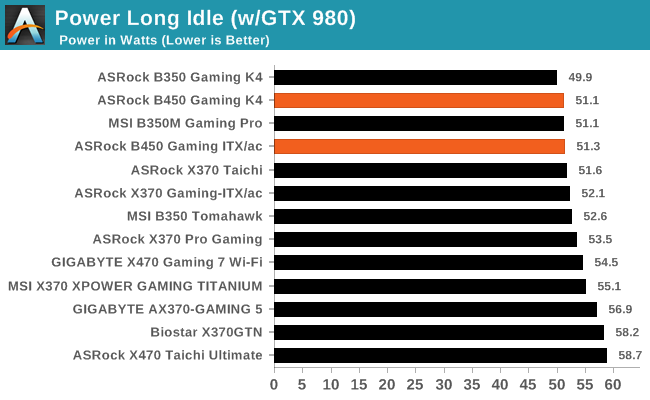
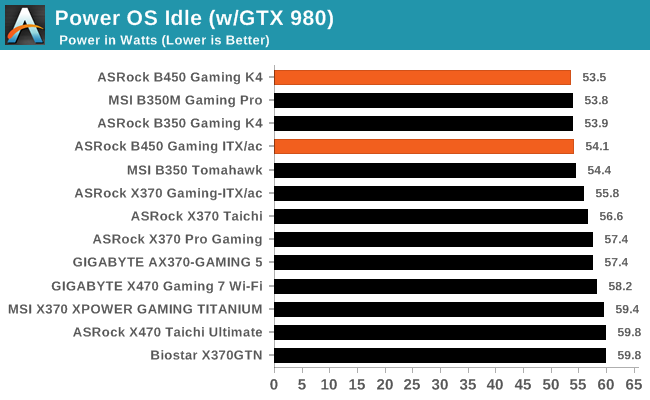
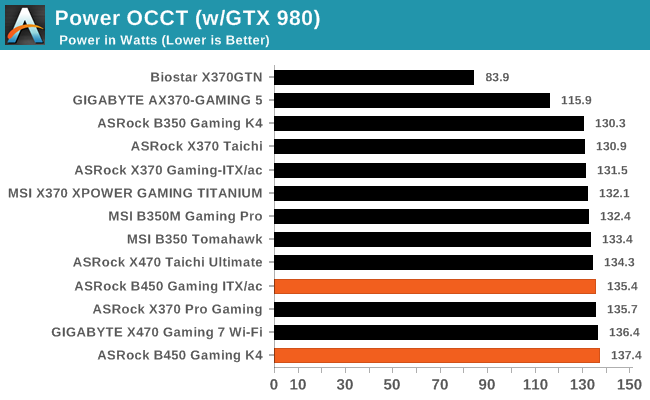
Both the B450 Gaming ITX/ac and B450 Gaming K4 motherboards perform very well at both of the test idle power states, but things go a little awry for the B450 Gaming K4 at full load with the highest power draw so far. From the previous B350 Gaming K4 board we tested, the B450 managed to somehow gain an additional 7 W of power at load which isn't all that much in the grand scheme of things, but it's still an increase to take note of.
Non-UEFI POST Time
Different motherboards have different POST sequences before an operating system is initialized. A lot of this is dependent on the board itself, and POST boot time is determined by the controllers on board (and the sequence of how those extras are organized). As part of our testing, we look at the POST Boot Time using a stopwatch. This is the time from pressing the ON button on the computer to when Windows starts loading. (We discount Windows loading as it is highly variable given Windows specific features.)
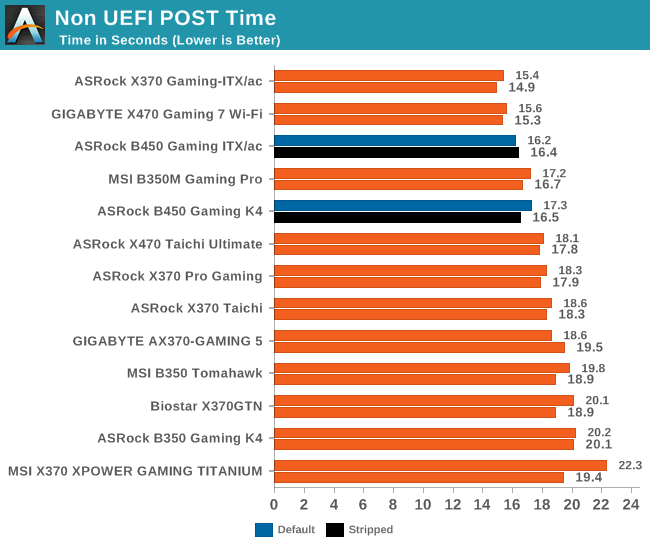
Three of the top five boards in our POST time are from ASRock, which shows a reliable and efficient POST sequence. Both the B450 Gaming K4 and Gaming ITX/ac make the cut and the ATX sized B450 board even manages to shave over a second off POSTing time with some onboard controllers disabled.
Rightmark Audio Analyzer 6.2.5
Rightmark:AA indicates how well the sound system is built and isolated from electrical interference (either internally or externally). For this test we connect the Line Out to the Line In using a short six inch 3.5mm to 3.5mm high-quality jack, turn the OS speaker volume to 100%, and run the Rightmark default test suite at 192 kHz, 24-bit. The OS is tuned to 192 kHz/24-bit input and output, and the Line-In volume is adjusted until we have the best RMAA value in the mini-pretest. We look specifically at the Dynamic Range of the audio codec used on the rear panel of the board.

The Realtek ALC1220 is one of the best performing and most widely used premium audio codec used on medium to high-end motherboards across the majority of chipsets, so the B450 Gaming ITX/ac puts in a good showing because of this. The B450 Gaming K4 makes use of a slightly lower grade, but cheaper Realtek ALC892 codec and the results reflect this.
DPC Latency
Deferred Procedure Call latency is a way in which Windows handles interrupt servicing. In order to wait for a processor to acknowledge the request, the system will queue all interrupt requests by priority. Critical interrupts will be handled as soon as possible, whereas lesser priority requests such as audio will be further down the line. If the audio device requires data, it will have to wait until the request is processed before the buffer is filled.
If the device drivers of higher priority components in a system are poorly implemented, this can cause delays in request scheduling and process time. This can lead to an empty audio buffer and characteristic audible pauses, pops and clicks. The DPC latency checker measures how much time is taken processing DPCs from driver invocation. The lower the value will result in better audio transfer at smaller buffer sizes. Results are measured in microseconds.
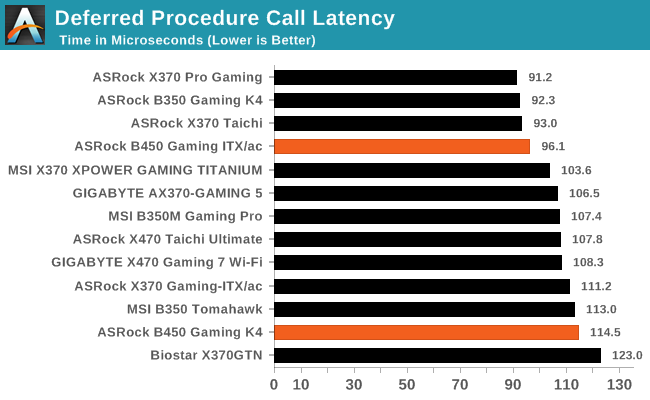
None of the AM4 motherboards tested thus far has been optimized for DPC latency, but ASRock does consistently post the best scores with the B450 Gaming K4 being one of the worst tested so far. The B450 Gaming ITX/ac however sits towards the top of the pack.










29 Comments
View All Comments
ToniCipriani - Tuesday, July 31, 2018 - link
Does anyone know if the M.2 slot below supports double-sided drives, or is it single-sided only?leexgx - Thursday, August 16, 2018 - link
cant see why not its not a laptopET - Tuesday, July 31, 2018 - link
It's interesting how the ASRock B450 K4 is significantly worse than the B350 version in many tests.I wonder if this result will change if a Ryzen 2000 series CPU is used.
hyno111 - Tuesday, July 31, 2018 - link
Seems they dropped the support for Bristol Ridge on all B450 boards.Actually I have yet to find any B450 board with Bristol Ridge support.
DanNeely - Tuesday, July 31, 2018 - link
this was discussed a few weeks ago. They ran out of room for additional hardware profiles in the BIOS and were forced to choose between using bigger and more expensive chips, or dropping the oldest CPUs from compatibility lists. Unsurprisingly for a budget product they're choosing to drop support rather than spend more for a niche case.https://www.anandtech.com/show/12971/amd-bios-limi...
Death666Angel - Tuesday, July 31, 2018 - link
Who in their right mind would go over a Bristol Ridge APU vs a Ryzen APU in a new bought system?StrangerGuy - Wednesday, August 1, 2018 - link
There are plenty of Ebay penny pinchers who can't be bothered to think about what "price/performance" means.DPete27 - Tuesday, July 31, 2018 - link
Poor Gavin. He's so tired his bloodshot eyes are making him see red heatsinks and RAM slots on the B450 ITX board.linuxgeex - Wednesday, August 1, 2018 - link
That and Gavin has started using Google Translate to convert from his apparently native Chinese to English, without any form of grammar checking afterward.u.of.ipod - Tuesday, July 31, 2018 - link
You keep mentioning the red heatsinks and RAM slots on the ITX board, yet the photos do not show red heatsinks or RAM slots.